Do you often find yourself sneezing and dealing with itchy eyes, irritated skin, or a stuffy nose?
You might be surprised to discover that the culprit could be lurking right under your nose – household dust. Dust is a common cause of allergies and a general nuisance that can make your living space feel less clean and comfortable. So, just how often should you dust your home to maintain optimum cleanliness?
I am going to share with you various factors that influence dusting frequency, recommended schedules, effective techniques, tools, and practical tips to keep your home as dust-free as possible.
Key Takeaways for How Often Should You Dust:
- Dusting frequency should be tailored to individual needs and preferences, taking into account household size, presence of pets, location and climate.
- A customized dusting routine is recommended for optimum cleanliness – weekly dusting for high-traffic areas & homes with allergy sufferers/pets. Monthly dusting of furniture & surfaces. Seasonal deep cleaning every 3-6 months.
- Tips include regular HVAC filter maintenance, decluttering/organizing the home and proper ventilation via fans or open windows/doors.

Factors That Influence Dusting Frequency
I know you’re looking for an answer to your simple question, but there are several factors to consider when determining how often you should dust. Some factors to consider include:
- Household size
- Presence of pets
- Location (e.g. urban or rural area, proximity to construction sites)
- Personal preferences
All of these factors can play a role in how much dust accumulates and how quickly it does so.
Understanding these factors allows you to customize your dusting routine, leading to a cleaner, healthier living environment.
#1 Household Size and Occupants
Obviously a household with more people is going to generate more household dust. More people means more dust. The reason for this is simple -human skin cells. Each person in your home contributes to the overall amount of dust by shedding dead skin cells.
Additionally, the more people living in your house, the more foot traffic and movement of items, which can stir up dust particles. So, it’s safe to say that larger households require more frequent dusting to keep dust at bay and maintain a cleaner living space.
If it’s just you, you don’t need to dust as much.
#2 Presence of Pets
How many pets do you have? Pet owners, beware: your furry friends contribute to the dust levels in your home, which can harbor dust mites. Pet hair and dander can significantly increase the amount of dust collecting on surfaces. Furthermore, pets that spend time outdoors can bring in dirt, pollen, and other debris.
Households with pets may need to dust more often, especially if they have allergy sufferers. Regular grooming of your pets and vacuuming with HEPA filters can help keep pet-related dust under control. Pay extra special attention to their favorite spots!

#3 Location and Climate
The geographical location and climatic conditions of your home can also play a significant role in dust accumulation. If you live somewhere like the Arizona desert, you are more prone to dust buildup due to the lack of moisture in the air and the prevalence of dust storms. On the other hand, humid climates may experience less dust accumulation but may have other challenges, such as mold and mildew growth.
Considering your location and climate is crucial when figuring out the dusting frequency for maintaining a clean home.
#4 Personal Preferences and Allergies
How often you dust your home can also depend on personal preferences and allergies. Frequent dusting becomes a necessity for those who suffer from allergies, to alleviate symptoms and ensure a comfortable living environment. If you have a family member that has an allergic reaction in your home, you will need to increase your dusting schedule.
Some households may choose to dust more often simply because they prefer a cleaner, more polished appearance. Ultimately, the frequency of dusting depends on your specific needs and preferences, so it’s essential to find a routine that works best for you and your household.
Recommended Dusting Schedules
Now that I’ve shown you the factors that influence dusting frequency, it’s time to discuss some recommended dusting schedules. Keep in mind that these schedules are not one-size-fits-all, and you should adjust them to meet the unique needs of your home.
Customizing your dusting routine to your specific situation helps maintain a clean and comfortable living space.
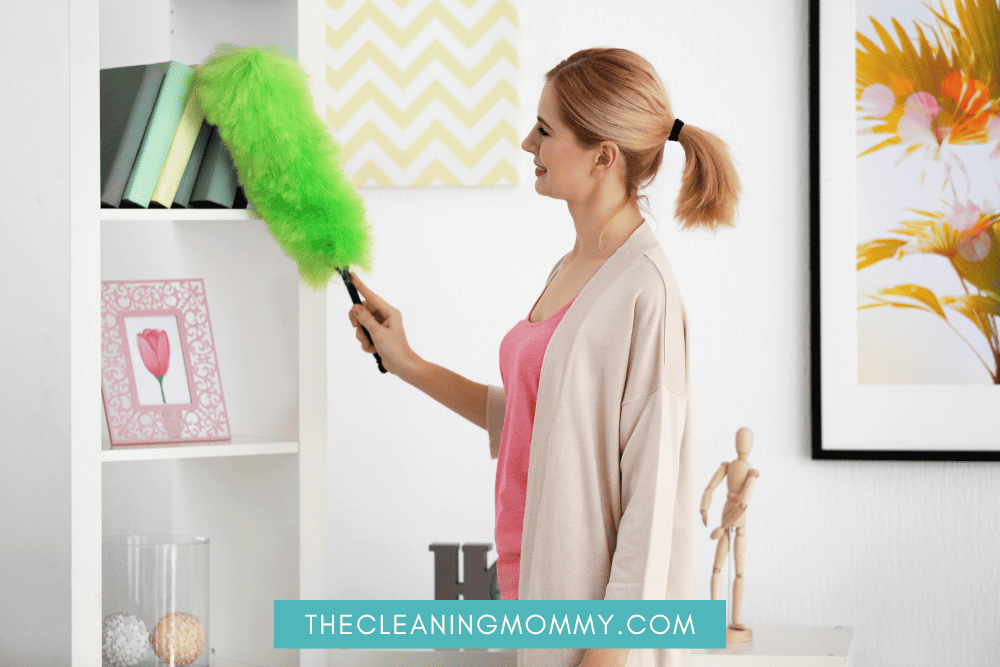
Weekly Dusting
So, how often should you dust?
I highly recommend that you dust weekly if you have pets and family members with allergies. During your dusting routine, focus on exposed household surfaces such as tables, shelves, door frames, light fixtures, high shelves, picture frames, and windowsills.
A quick wipe with a microfiber cloth or a microfiber duster can efficiently remove dust and dirt, helping to maintain a cleaner environment and better air quality. Sticking to a weekly schedule should help to keep most household dust at bay.
For homes with pets, consider vacuuming with a HEPA filter to capture pet hair and dander more effectively.
Monthly Dusting
Monthly dusting is suitable for most homes, focusing on accessible areas and surfaces like:
- furniture
- shelves
- window sills
- baseboards
Use a microfiber cloth or feather duster to easily remove dust and dirt, starting at the top of the room and working your way down. This top-to-bottom approach ensures that you capture all the dust without having to re-dust areas you’ve already cleaned.
If you’re not already doing so, consider incorporating vacuuming with a HEPA filter into your monthly routine to further reduce dust accumulation and improve your air quality.
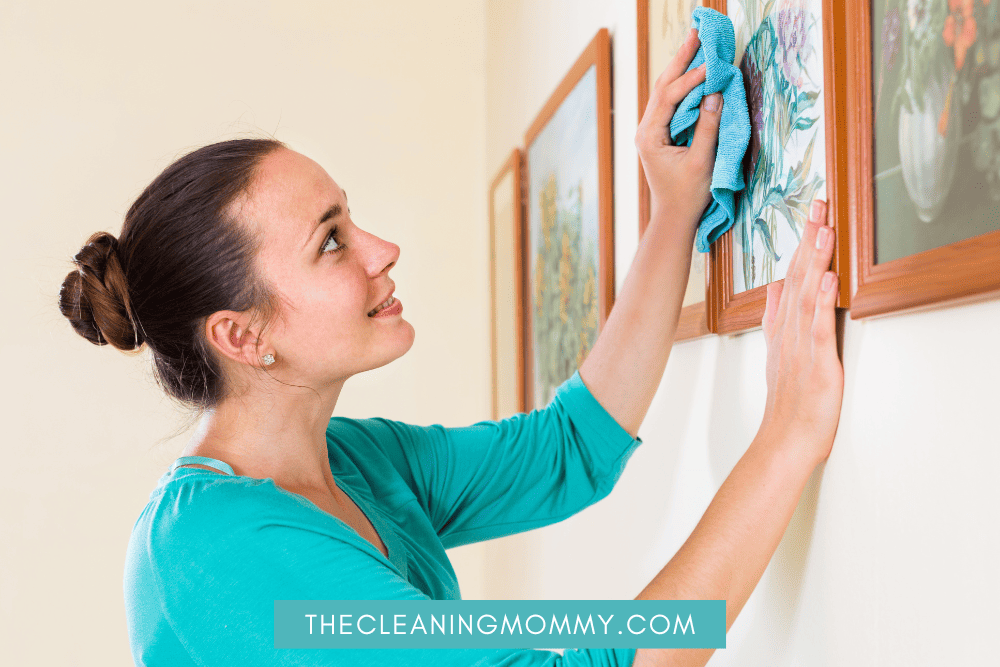
Seasonal Deep Cleaning
Seasonal deep cleaning with some elbow grease every 3-6 months can help maintain a clean and healthy home by addressing hard-to-reach areas and thorough dusting. During a seasonal deep cleaning, make sure to dust all surfaces and furniture, including doors, wall vents, blinds, ceilings, ciling fans and light fixtures.
It’s also a great time to clean.
- windows
- blinds
- curtains
- walls
- floors
Be sure to get your seasonal deep cleaning on your regular cleaning schedule, this can really make a difference to maintain your home’s cleanliness and comfort throughout the year.
Dusting Techniques and Tools
Having the right techniques and tools at your disposal can make all the difference when it comes to effective dusting.
In this section, we’ll discuss some of the most effective dusting techniques and tools, such as microfiber cloths, the top-to-bottom approach, and vacuuming with HEPA filters.
Employing these cleaning tools and methods, including a brush attachment, helps keep your home as dust-free as possible.
Microfiber Cloths and Dusters
Microfiber cloths and microfiber feather dusters are highly recommended for effective dust removal. These cleaning products are made of synthetic fibers that are exceptionally effective at trapping and holding dust particles, rather than spreading them around like traditional cleaning cloths or dusters.
Microfiber cloths can be used either wet or as a dry microfiber cloth on any surface in your home, providing an alternative to paper towels. They are non-abrasive, hypoallergenic, and can be easily washed and reused, making them an eco-friendly and cost-effective choice for dusting. When used as a damp cloth, they can effectively clean surfaces without leaving streaks or residue – this is a big deal!
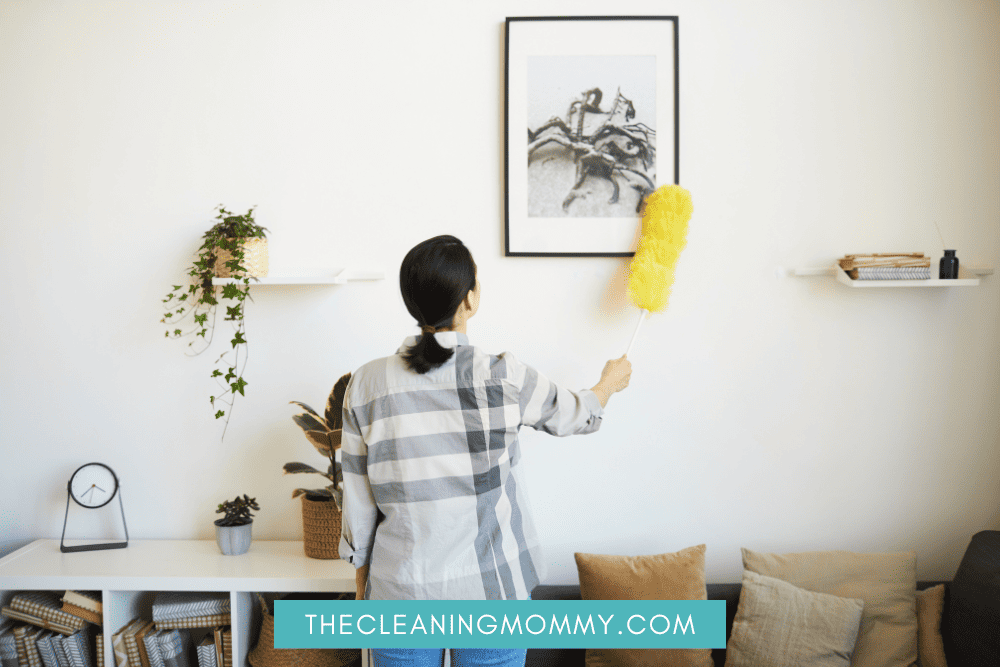
Top-to-Bottom Approach
The top-to-bottom approach in dusting ensures that dust settles on lower surfaces before being cleaned, preventing the need for re-dusting. Start at the highest point of the room, such as a ceiling fan or light fixtures, and work your way down to lower surfaces like furniture and baseboards.
This method effectively captures all the dust and helps eliminate dust in the room, allowing you to clean more efficiently and save time in the process.
Vacuuming with HEPA Filters
Vacuuming with HEPA filters is another effective way to remove dust from surfaces and the air in your home. HEPA filters are designed to capture particles up to 0.3 microns in size, including dust, pollen, and pet dander.
By using a vacuum cleaner with a HEPA filter, you can improve the air quality in your home and reduce the amount of dust and allergens in the atmosphere. This can be particularly beneficial for individuals with allergies or respiratory problems who are sensitive to dust and other airborne particles.
Tips for Reducing Dust in Your Home
While dusting is an essential part of maintaining a clean home, there are also several other measures you can take to reduce dust accumulation.
In this section, I’m going to provide you with some practical tips for reducing dust in your home, including regular HVAC filter maintenance, decluttering, and proper ventilation.
Implementing these strategies aids in minimizing dust buildup, fostering a cleaner, healthier living environment.
Regular HVAC Filter Maintenance
Most of the air circulation comes through your HVAC system, so regularly changing your HVAC filters is an important step in reducing dust accumulation and improving air quality in your home. Dirty or clogged filters can cause dust and other airborne particles to circulate throughout your home, contributing to poor air quality and increased dust buildup.
To maintain optimal performance, it’s recommended to replace HVAC filters every 3 months or as suggested by the manufacturer. Maintaining clean HVAC filters aids in purifying the air in your home and reducing the amount of dust that settles on surfaces.
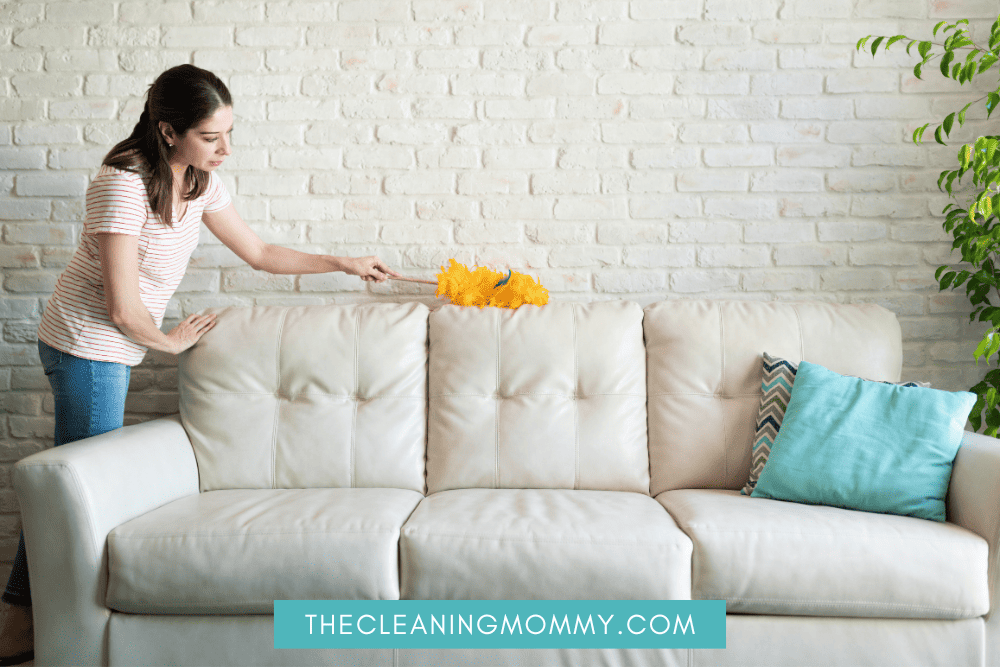
Decluttering and Organizing
Decluttering and organizing your home can have a significant impact on reducing dust buildup. By minimizing the number of dust-collecting surfaces in your home, you can make cleaning more manageable and help prevent dust accumulation.
To declutter, follow these steps:
- Assess your possessions and determine which items should be kept, donated, or discarded.
- Organize the items you keep in designated locations to maintain a tidy living space.
- Keeping your home clutter-free streamlines dusting and cleaning tasks, resulting in a cleaner environment.
- How to declutter your kitchen like a pro
- How to declutter your room
- How to declutter when you are totally overwhelmed
- How to declutter when your spouse doesn’t want to
- 130+ Things to declutter in your home right now
Proper Ventilation
Proper ventilation is another key factor in maintaining good air quality and reducing dust buildup in your home. Here are some ways to improve ventilation and reduce dust.
- Ensure your home has adequate air circulation
- Utilize fans to facilitate air movement
- Employ air purifiers to filter out dust and other airborne particles
By implementing these measures, you can improve the air quality in your home and minimize dust buildup.
Opening windows and doors to allow fresh air in can also help to dilute indoor pollutants and improve overall air quality. Maintaining appropriate ventilation in your home contributes to a healthier living environment and minimizes dust accumulation.
Summary
In conclusion, maintaining a clean and dust-free home is essential for your health and comfort, and that of your family. By understanding the factors that influence dusting frequency, implementing recommended dusting schedules, and utilizing effective techniques and tools, you can ensure that your home remains as clean and comfortable as possible.
Additionally, by following the tips provided for reducing dust accumulation, such as regular HVAC filter maintenance, decluttering, and proper ventilation, you can create a healthier living environment for you and your family.
So, roll up your sleeves and start dusting – your home and your health will thank you for it!
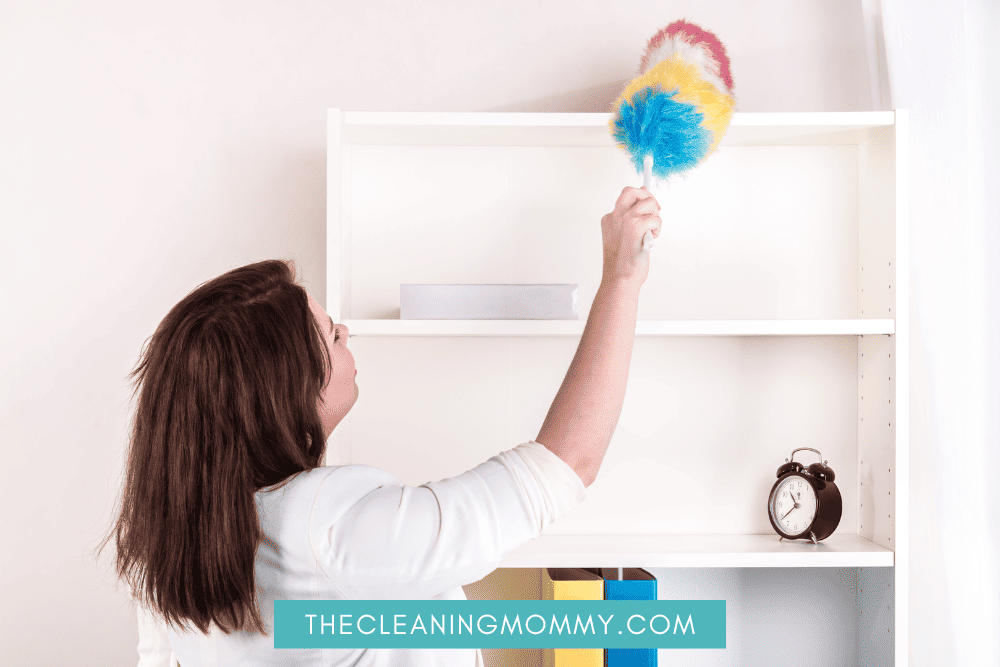
Frequently Asked Questions
How often should you dust?
For optimal air quality, dust your home at least every other week – choose a regular time or spread it out over the week.
You can make this task easier by setting a regular schedule. For example, you could dust on Mondays, Wednesdays, and Fridays. Or, you could dust one room each day. Figure out a cleaning schedule that works for you.
What happens when you don’t dust?
Not dusting or vacuuming can cause an increase in allergens in your home, such as pollen, pet hair, and dust mites.
This can make your allergies worse, leading to watery eyes and runny noses. Regular dusting keeps your home fresh from allergens.
How much dust is normal in a house?
Dust is inevitable in the home, with it being composed of pollen, fibers, and dead skin cells.
Housewife How-To’s reports that a typical house accumulates 40 lbs of dust yearly.
What are the advantages of using microfiber cloths for dusting?
Using microfiber cloths for dusting is a great option due to their excellent dust trapping and holding capabilities, non-abrasive material, hypoallergenic properties, and ability to be reused. They grab the dust and keep it – less dusting for you to do, as you don’t have to redo it again!
Happy cleaning!
How Often Should You Dust Your House?
More Like This
- how to clean non removable couch cushions
- how often should you clean your floors
- how to clean a glass table
- Our Uber popular speed cleaning checklist
- Deep cleaning living room checklist
- Things to declutter in your home
- Keep a clutter free home
- How to get your kitchen countertops clutter free

Grainne Foley
Grainne Foley is a wife and mother of 2 great kids. During her 5 years of full time RV travel, Grainne learned to become very efficient at household chores, in order to make time for family adventures. Now, back in a house, she has continued to create tools and techniques to help others lighten the load of household organization and cleaning.


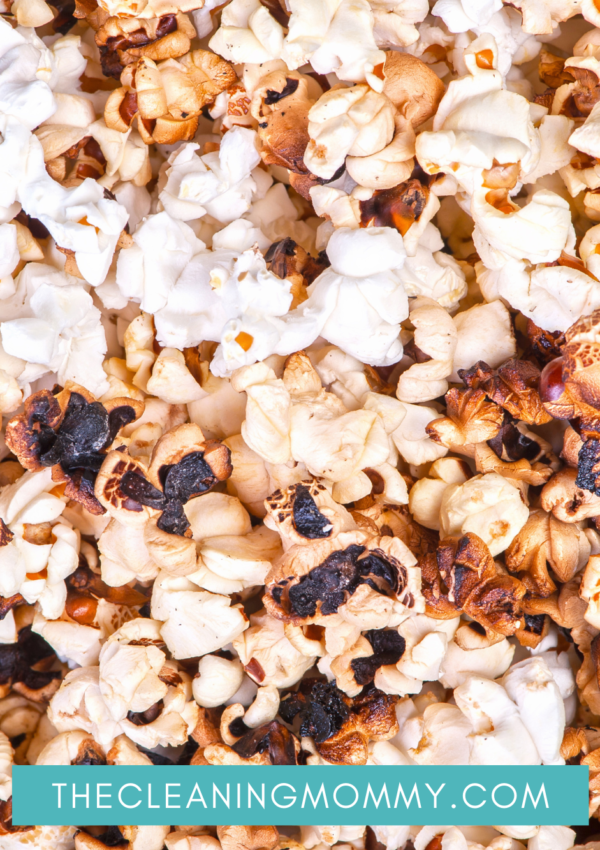
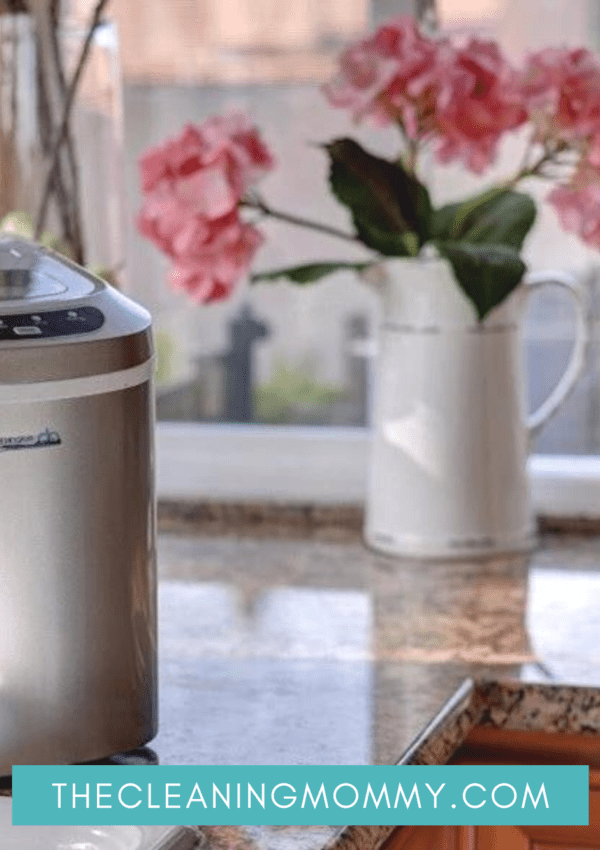

Leave a Reply